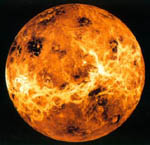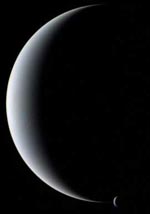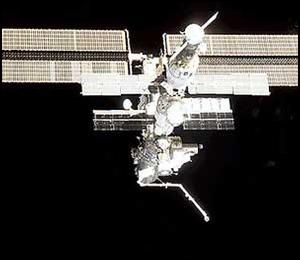
![]() Main Page
Main Page
![]() Feedback
Feedback
 The Author
The Author
 News
News
 Search
Search
 The Planets
The Planets
 Mercury
Mercury
 Venus
Venus
 Earth
Earth
 Mars
Mars
 Jupiter
Jupiter
 Saturn
Saturn
 Uranus
Uranus
 Neptune
Neptune
 Pluto
Pluto
 Dwarf Planets
Dwarf Planets
 The Solar System
The Solar System
 The Sun
The Sun
 The Moon
The Moon
 Meteors
Meteors
 Comets
Comets
 Asteroids
Asteroids
 Amazing facts
Amazing facts
 Other
Resources
Other
Resources
 Poster Store
Poster Store
 Multimedia
Multimedia
 Links
Links
 Awards
Awards
 Glossary
Glossary
 Astronomers
Astronomers
 Webrings
Webrings
 Bibliography
Bibliography
The Planets
![]()
The Solar System as we know it today contains 8 planets - the four rocky inner planets of Mercury, Venus, Earth and Mars, and then the four gas giants, comprising Jupiter, Saturn, Uranus and Neptune, with these two distinct groups seperated by the Asteroid Belt. There are also 3 known dwarf planets - objects not quite large enough to be considered proper planets, but too big to be thought of as mere asteroids or rubble. These are Ceres, Pluto and Eris (more on them below).
Differences between inner & outer planets

In the Solar System, we have
two groups of planets - the outer gas giants and the inner rocky ones. The rocky ones are
the first four, which are much smaller and denser than the outer four, containing a much higher
percentage of metal elements, and less gases (Mercury and Mars do not in fact have any atmosphere to speak of). Even Venus'
thick, scorching atmosphere only accounts for a small fraction of its overall composition.
The other four are instead a lot larger and have very dense atmospheres with (relatively) small cores.
The reason for this
state of affairs, put simply, is that when the Solar System was born, most of the gases near the Sun
were soon either vapourised or blown away by the Solar wind so that only heavy metal &
rock materials were left to form the inner planets. Further away though there was plenty
of gas and this accumulated together to form behemoths the size of Saturn and Jupiter.
Planets give out heat too...
In the outer Solar System, the planets recieve much less light and heat from the Sun, as they are much further away, and the Solar radiation travelling outwards behaves according to an inverse square law. It is thus much easier to detect the small amounts of heat and light given out by the planets themselves. All planets give out energy to some degree; the terrestrial ones by slow radioactive decay of isotopes formed since the planet's formation, the gas giants emit heat left over from the planets' final phases of contraction when they were formed. With the exception of Uranus, the gas giants emit more heat than the terrestrial planets.
Inner Planets
 The inner planets, Mercury, Venus, Earth and Mars, can be (very) roughly split into 2 sub-groups. The first and last
of the inner planets, Mercury and Mars respectively, are both comparatively small (Mercury has a diameter of 4,800km and Mars of
6,700km compared to Earth's 12,800km) and have no atmospheres to speak of.
The inner planets, Mercury, Venus, Earth and Mars, can be (very) roughly split into 2 sub-groups. The first and last
of the inner planets, Mercury and Mars respectively, are both comparatively small (Mercury has a diameter of 4,800km and Mars of
6,700km compared to Earth's 12,800km) and have no atmospheres to speak of.
The middle two planets, Venus and Earth on the other hand, are very similar in size (Venus has a diameter of 12,100km to Earth's 12,800km) and have a similar composition, mass and density. However, Venus' position slightly closer to the Sun has resulted in a 'runaway greenhouse effect' creating a scorching, styfling inferno on the surface of the planet, whereas Earth is much more temperate.
Outer Planets
 For the outer planets, the division is more distinct, with the inner two gas giants, Jupiter and Saturn being quite
different in many ways
from the outer two gas giants, Uranus and Neptune. In terms of size, Saturn, with a diameter of 120,000km is not a world away from Jupiter,
with a 142,000km diameter. However the other two planets, Uranus and Neptunes have diameters of 'only' 51,800km and 50,000km respectively - roughly
the size of the core of Saturn or Jupiter.
For the outer planets, the division is more distinct, with the inner two gas giants, Jupiter and Saturn being quite
different in many ways
from the outer two gas giants, Uranus and Neptune. In terms of size, Saturn, with a diameter of 120,000km is not a world away from Jupiter,
with a 142,000km diameter. However the other two planets, Uranus and Neptunes have diameters of 'only' 51,800km and 50,000km respectively - roughly
the size of the core of Saturn or Jupiter.
This large size difference is responsible for many other differences between the two groups, for instance Jupiter and Saturn both have sufficiently high internal pressures to 'squeeze' large quantities of Hydrogen into a metallic state in their cores, whilst Uranus and Neptune can produce only a tiny fraction of this amount. As a consequence, their magnetic fields are much smaller than those of Saturn and Jupiter, whose magnetic fields are generated in large part thanks to electrical currents moving through this material.
Dwarf Planets
This category of object is a recent creation (2006), introduced to accomodate objects orbiting the Sun which are not quite large enough to be termed 'planets', but whose size warrants them a special classification above 'asteroid' or floating object. The criteria for a dwarf planet are that it must orbit the Sun, have enough mass such that its gravity causes it to be almost round in shape, and it must not be a satellite of another planet. The closest dwarf planet to the Sun is Ceres, which lies within the asteroid belt, then there is Pluto, which normally lies just beyond Neptune, and finally there is Eris, discovered in 2005, which normally lies beyond Pluto.
To learn more about dwarf planets, see the Dwarf Planets page.
Kuiper Belt
The Solar System does not end with either Pluto or Eris, for as mentioned earlier there is another large 'belt' of objects orbiting the Sun, a belt covering a much greater area and containing a much greater mass than the asteroid belt. This belt is called the Kuiper Belt, and it is a fairly recent discovery - the first evidence for it was only found in the mid 1980s so we still do not know a lot about it. Most Kuiper Belt Objects, or KBOs, have not yet been seen by astronomers, and it is expected that there are a large number, perhaps greater than 40 or 50, whose size is comparable or greater than that of Pluto. It is this reason that primarily caused the IAU to invent the 'dwarf planet' label due to the fear that otherwise there could be 40 or 50 new 'planets' to add to the list over the next few decades.
So far, KBOs have been seen from distances ranging from 30AU to 50AU from the Sun (for reference, Pluto's average orbit is at about 39AU). It is estimated that the total mass of KBOs in this region is just above that of Mercury. However it is also thought that the Kuiper belt could extend to a potential distance of 1000AUs from the Sun!

Exploration
Many probes, satellites and rockets have been sent out to different planets and it is hoped that soon there will be manned missions to the Moon and Mars. The only manned landings so far have been in the late 1960's (69) and 70's with the Apollo missions. The first man in space was the Russian Cosmonaut Yuri Gagarin in 1961 and the first satellite was the Russian Sputnik in 1958. The first man to have a 'spacewalk' was Cosmonaut Alexi Leonov. There have been no disasters involving the deaths of human lives in space, though in 1970 Apollo 13 experienced a few difficulties.
At the moment however, the main goal the big space agencies are working towards is the International Space Station which is at present orbiting the Earth with a crew always on board. In 2004, both Europe and America made their intentions clear to press on with manned spaceflight by aiming to establish permanent manned bases on first the Moon, and then Mars, within the next half-century. It remains to be seen if this will be achieved.
There are no big dangerous weapons in space, although that is set to change if the american military get their way.
Click on the text above the planets below to find out more about them:










